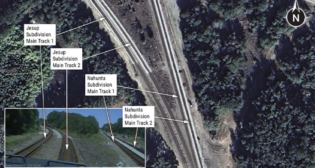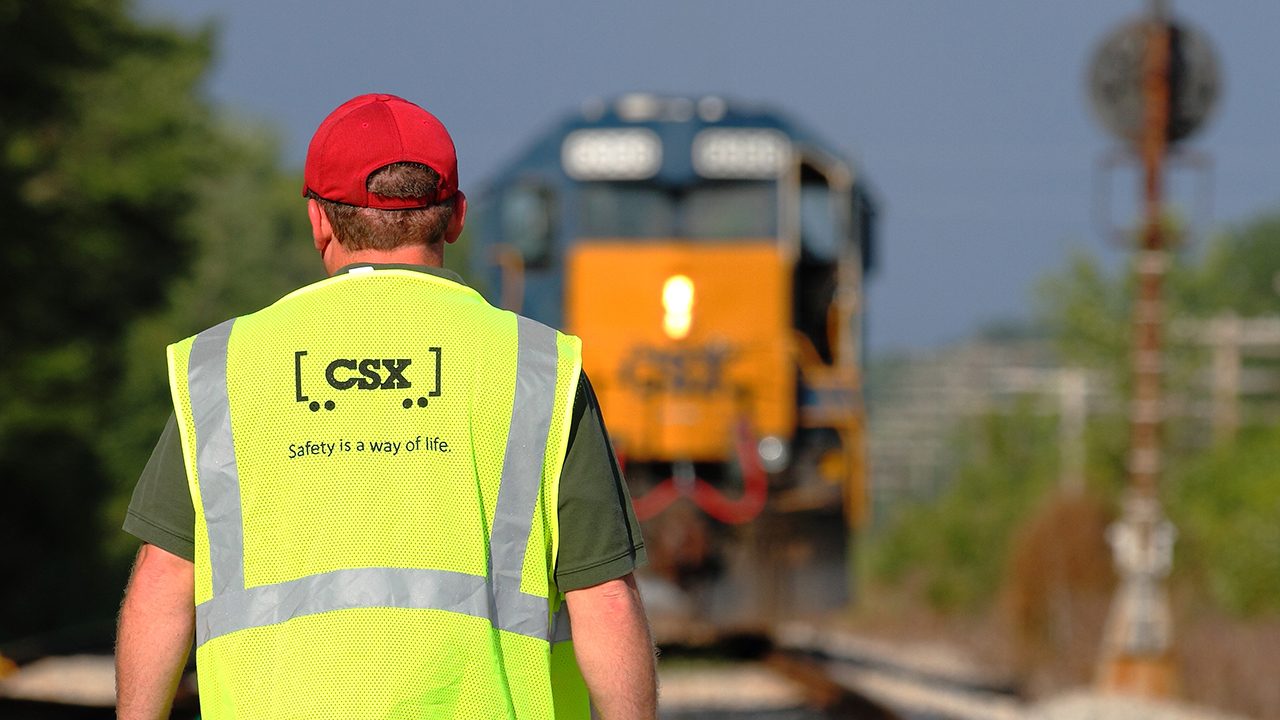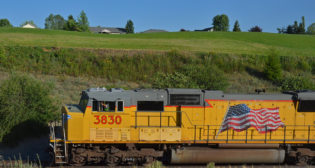
Railroads at Midyear: In the Clear?
Written by William C. Vantuono, Editor-in-Chief
William Beecher photo
RAILWAY AGE, JULY 2023 ISSUE: You might call 2023’s first half a perfect storm, the historic CPKC merger the one calm, hopeful spot in a churning ocean of troubles. But nothing lasts forever. There are strong examples of service recovery. Is it “clear track ahead” for the railroads?
Don’t take at face value anything appearing so far this year in the general media about the freight rail industry. Yes, we have problems to be solved (and we’re addressing them). Who doesn’t? Yes, traffic is down, but traffic is cyclical, as is the economy. The public has been buying into the dissonant racket produced by tone-deaf, self-serving politicians, at all levels, instead of the facts. Special-interest groups continue their ceaseless attacks: “Railroads are unsafe. Greedy. Uncaring. Terrible places to work. Poor service providers. In need of more regulation. Blah blah blah …”
It’s mostly noise. È principalmente un mucchio di sciocchezze, or as my Uncle Alberto liked to say, “a bunch of balle (malarkey).” Are we beating ourselves up to appease those beating up on us? If so, it’s time to start saying (respectfully, of course), “Hey, wait a minute. Look at the facts. Here is the truth. Stop poking us in the eye with a sharp stick, and remove the log from yours.”
Example: The Surface Transportation Board over the past 29 quarters (1Q16-1Q23) registered 10,740 “Informal Service Complaints,” which incorporate all types (phone calls, letters, emails, etc.), do not involve a formal filing with a corresponding docket number, and are usually addressed through mediation. That’s an average of 370 per quarter, or 124 per month, in round numbers.
STB “Railroad Service Issues,” which involve a formal filing requiring both parties to respond, averaged 30 per quarter, or 10 per month. Divide this figure by the average number of U.S. Class I freight train starts per month (based on Association of American Railroads data)—150,000—and you get 0.00007. That’s a rounding error.
So, the answer to “is railroad service poor?” is “no,” based on the number of formal, docketed complaints.
The same goes for safety. We all know the statistics, as AAR tells it: “Thanks in part to multi-layered inspection practices, FRA data show that the past decade has been the safest ever for railroads, with the Class I railroads’ main line train accident rate down 44% and the equipment-caused accident rate down 21%.”
Let’s dig a little deeper and take a look at some HBD (hot bearing detector) data. HBDs suddenly became the poster child following Norfolk Southern’s East Palestine accident—you know, the railroad-caused National Dystopian Nightmare that all people living within 10 miles of a railroad track must fear.
In March, Railway Age obtained the following 2022 statistics for NS on HBD readings and resulting actions:
- • 2.2 billion: Number of bearing temperature readings sent to NS headquarters in 2022.
- • 618: Number of times an HBD triggered a train crew to stop the train.
- • 353: Number of times the issue was resolved and the train proceeded.
- • 181: Number of times equipment was damaged and the issue was resolved.
- • 84: Number of times an overheated bearing was discovered and the car was removed from the train.
- • 876: Number of times trending analysis at the wayside detector help desk stopped a train before an alarm went off.
- • 158: Number of times a car was removed from the train due to trending analysis.
- • 308: Number of times a car was inspected and no issue was discovered.
- • 14: Average number of miles between HBDs.
So, in 2022, NS removed 242 cars from trains due to roller bearing heat problems. Divide that number by 2.2 billion temperature readings (every wheelset on every train that operated on the entire NS system in 2022), and you get 0.000001. That makes the odds of an East Palestine-type derailment (one caused by a roller bearing failure) literally one in a million. This doesn’t make the accident and its effect on the community something to dismiss. It is, however, very clear proof that those who preach railroads are unsafe really don’t know what they’re talking about.

AAR Lines on Labor
As to the skilled people who operate and maintain our national network, their situation has been improving. “It has been six months since the last round of national collective bargaining concluded, and while this process was undeniably challenging, the results were resoundingly positive, with further progress continuing to this day,” AAR President and CEO Ian Jefferies recently noted. “In the end, rail management and labor agreed to historic deals that included a 24% wage increase, best-in-class health care and a path to make meaningful progress in creating more predictable, scheduled work shifts for many freight rail employees.
“Railroading is tough, essential work that keeps our nation moving and must be done in person regardless of the weather or global pandemics. Like other American workers, employee priorities evolved in the face of COVID-19, bringing sickness benefits into the spotlight during the round’s final days.
“At the close of the national round, railroads committed to continuing work with their unions to make further progress on quality-of-life matters at the local level. In the months since railroads and their unions have come to the table to ink agreements that do just that. Today, railroads have reached new paid sick leave agreements to cover a majority of their employees.

“Here are the details: Since the conclusion of the national bargaining round in late 2022, 40 new sick leave agreements have been reached across the National Carriers’ Conference Committee carriers with all unions, 10 of which did not previously have a set number of traditional paid sick days. As of May 24, most of the unions at the NCCC carriers, representing 57% of all craft employees, now have paid sick leave days in addition to pre-existing short- and long-term paid sickness benefits already in effect across the industry. While not all agreements are the same, they are all the result of bargaining, just as they should be. Moreover, in collaboration with their labor unions, multiple railroads have also moved the ball forward to give operating craft employees greater scheduling predictability, making significant improvements on work-life balance priorities. Without a doubt, there is more work to do. Yet this recent progress, along with last year’s landmark national agreement, reflects the value rail employees provide as they safely deliver goods to customers and communities across the country every day of the year.
“These positive developments are supported by employment data, as the total Class I employment in April 2023 reached 121,391, marking an impressive 8.2% increase since January 2022 and the highest level since April 2020.”
TD Cowen Insight

TD Cowen’s rail analysts, led by Railway Age Wall Street Contributing Editor Jason Seidl, offer the following analysis on the potential impact of pending rail legislation and STB actions:
“In the near term, U.S. Class I’s are facing two major regulatory themes of relevance to investors: reciprocal switching and railway safety. Reciprocal switching rules, likely to be finalized in the near term, should be a negative for the U.S. Class I stocks, in our view, but are a 2025 and beyond story. The remedy, aimed at boosting competition, involves a rail carrier performing a short-haul move for its captive shipper and handing the freight over to a competitor for the long-haul move. While reciprocal switching rules have been in the spotlight at the STB for a long time and investors have known that these regulations are in the works, the potential impacts to Class I earnings have largely been left unquantified.
“Our estimates suggest that a –2% to –9% annualized EPS impact range will be realized over a multi-year period likely starting in late 2024 or 2025. Three things in the proposed rules can move the needle on impacts: 1) interchange radius, 2) whether the ruling offers blanket accessibility as opposed to restrictions to certain locations, and 3) whether the ruling specifies a different mileage range on East vs. West to account for lower density on the Western network.
“At a recent Fireside Chat, STB Chair Marty Oberman noted that the STB continues to work ‘feverishly’ on reciprocal switching rules, suggesting to us that a proposed rule is highly likely to be announced by the end of the year. A rule proposal is not a final act of approval, as it will be followed by a comment period, the duration of which will be set at the discretion of the Board. Oberman’s commentary indicated that strong opposition to proposed rules typically prompts multiple rounds of comments. This is likely to be the case with reciprocal switching rules, leading us to believe that though a proposed rule is on the near-term horizon, switching is nonetheless a 2025 and beyond story.
“Our discussions with Class I management teams suggest that new switching rules are unlikely to prompt significant capital expenditures, unless uniquely called out in legislation, as volumes at individual facilities are typically not sufficient to justify the investments, which may result in declining service quality. As a result, we believe our 30% estimate, which is limited to carloads that are already close to interchange facilities, is a reasonable upper bound for shipper eligibility. Our proprietary survey results suggest that 72% of shippers support the rules with 87% of shippers expecting a decline in their rates due to increased competition among carriers. We believe top-line implications would take a few years to materialize based on our analysis of Canada’s experience with extended interswitching from 2014-17, in which grain shippers only began availing interchanges in 2016.
“Following East Palestine, legislators put forward bills aiming to improve rail safety standards, with the Railway Safety Act, originated in the Senate, gaining the most traction. The bill includes a wide range of measures, some with tenuous connections with the recent derailment, and will likely be rationalized over the course of discussion in Congress. Elements of the bill germane to the derailment include: 1) HBD standards and installation mandates, and 2) expedited DOT-117 tank car phase-in. We do not expect HBD installation mandates to amount to significant capex outlay for the Class I’s.
“We see new rail safety regulations as a potential minor headache for railcar lessors and largely a net-neutral for railcar manufacturers. We are keeping our eyes on other potential safety regulations. HBDs are not the only changes we expect in terms of new safety regulations. The current rail safety bill is likely to change from its current format. We are keeping a ‘close eye’ on it but do remain concerned with the mandatory two-man crew provision. Our issue with this proposed mandate is that it handcuffs the industry in competing with autonomous trucks, who in many states are being assisted by the legislative process.
“More broadly, we believe the STB will continue to be actively involved in competition-enhancing regulation over the next five years. Oberman noted that rules on bottleneck segments and the development of new shipper-appropriate service metrics are additional focus points. If Oberman is reappointed to another five-year term at the end of December, which is likely in our view, we believe the STB’s focus on enhancing competition among the Class I’s will remain robust. Indeed, it is likely that further regulation will negatively impact railroad earning power beyond 2024 to some extent.
“Most recently, congestion in the aftermath of pandemic-related disruption drew significant complaints from shippers regarding service quality. The STB drew attention to labor problems at the Class I’s and urged them to rebalance their resourcing to adequately meet demand. In April 2022, the STB summoned rail executives to an unprecedented two-day hearing to explain the causes of poor service. The STB subsequently required the Class I’s to submit detailed service recovery plans to the Board including service KPI targets and pathways to achieving them with a focus on rehiring. According to the relevant docket, the STB chose to give Class I’s the chance to demonstrate how they would ‘resolve the service problems themselves,’ which in turn ‘minimizes the need for further regulatory intervention.’ Nonetheless, the Board disclosed that it may levy fines of up to $8,736 per violation per day, adjustable for inflation, if it deemed Class Is’ plans insufficient to rectify service problems.
“In our view, STB pressure played an assistive role in prompting rehiring efforts at the Class I’s. Reliable service is key to Class I long-term plans to effect greater truck to rail freight conversions, and rehiring would have naturally emerged as a significant priority in response to the congestion. STB oversight of Class I service quality should continue to be assistive and transparency-focused in nature as opposed to punitive.”
CSX Sets an Example

Following the arrival of new President and CEO Joe Hinrichs, the CSX operating team, led by Executive Vice President Operations Jamie Boychuk, has posted industry-leading service metrics. Loop Capital Managing Director Rick Paterson recently conducted an extensive interview with Boychuk, highlights of which follow.
PATERSON: It’s inarguable that CSX engineered the best recovery following its operational inflection last July. Current service is close to best-ever. How did the operating team achieve this?
BOYCHUK: The key was to continue to operate our balanced operating plan. As we improved our active T&E headcount, we saw clear improvement in our overall ability to run the plan, which is much more than just managing the time it takes a train to get from point A to point B. The plan starts at the car level. The amount of time between a car arriving and departing a terminal is crucial for the fluidity of every location on our network. There are standards on the amount of time from arrival to hump/switch; switch to outbound track; and outbound track to depart. Being able to consistently meet these standards is a big key to our success, and having enough crew capacity has been a key factor. Last year, the situation was at a point that we were hiring at all locations. Now, thanks to the efforts of so many people across our company, we are in a better place where we can concentrate our hiring more selectively on certain pockets across our railroad. It’s also important to recognize the positive impact of the efforts we’ve been making with our ONE CSX initiative to build an even more effective workplace culture. Over this past year, we’ve adjusted our attendance policies, and CSX was the leader in reaching agreements on sick pay. We still have a long way to go, but our leadership team strongly believes that our people perform better when they feel valued and respected and have a better quality of life.
PATERSON: Given the recent spate of meltdowns within the industry, we’ve all been painfully reminded that strong Class I rail service is a rare and valuable commodity. It’s easy to lose, and when it’s gone it’s a long, hard road to get it back. It’s also proven to be very difficult for any Class I to run consistently well for extended periods of time (multiple consecutive years for example). Given CSX is now at the top of the service mountain, what, specifically, is the operating team doing that is new or different from the past in order to entrench and institutionalize service resiliency so that the 2022 meltdown proves to be its last meltdown? Put another way, what changes are being made that should give customers confidence that good CSX service is here to stay?
BOYCHUK: Running the plan at CSX is here to stay. Sticking to the principles of scheduled railroading, executing the plan, analyzing the plan, making tweaks to the plan as necessary, then executing the plan again is a cycle that we are constantly running. The operating team understands that this daily execution is of utmost importance. An analogy of a successful football team: At the start of the season, the coaching staff has a game plan. The plan is communicated and practiced by the team. The team is united and understands the plan. Every member must be running the same plan on every play. Over time, as the team progresses through the season and studies game film, the game plan may need to be tweaked. The coaches adjust the game plan, communicate this to the team, and the team practices and executes. Overall, running the plan allows for recovery and resiliency. The assets (crew, power, cars) get back into cycle and will again allow the team to execute, analyze, and tweak if necessary. CSX has been able to leverage the importance of the operating plan to allow the scheduling of track maintenance. Our consistency allows our track forces to operate all hours of the day, taking advantage of windows to get maintenance accomplished.
PATERSON: In terms of operational philosophy, there seems to be a spectrum of views on whether to, at one extreme, schedule as much of the traffic as possible to maximize network predictability, and at the other end of the spectrum hold trains—particularly bulk—to maximize for train length and tonnage and minimize train starts. Where is CSX operations on this issue?
BOYCHUK: Do not hold for tonnage. This creates more of a problem, and a balanced network is immediately thrown out the window. It also takes away the discipline that is built into a railroad. In our terminals, our yardmasters and yard crews need to be building the same trains and operating the same plan every day. Blocks of cars move from the same track to the same outbound train every day. Holding traffic will cause disruptions to the planned activities inside every yard and put trains out of slot on the line of road. Maximizing trains for length or tonnage will have a major negative impact on any flexibility for future growth. It will cause imbalances to the network and drive the need to add train starts.
PATERSON: Should railroads that are not running well adopt more of a scheduled philosophy, and then get more creative with holding for tonnage on a higher proportion of train starts as they run better and become more operationally adept?
BOYCHUK: We believe strongly in running a railroad that operates 24×7 with an operating plan considered sacred by the operations team. It can be debated how often you need to show up at a customer facility, the way a train is built or blocked, or the number of hump and switching yards required, but adoption of a 24×7 operating plan that looks the same every day is fundamental. There will be disruptions, but the plan must still be operated repeatedly. Having the right amount of assets on the network (both physical and human) allows for the operation of a realistic and achievable plan, which also helps to drive customer satisfaction and allows for a favorable work environment for our employees.



